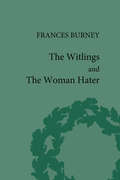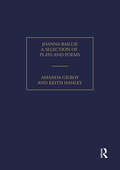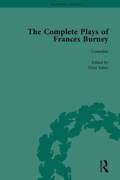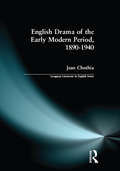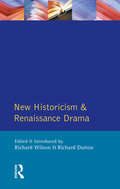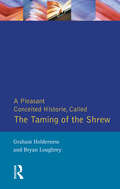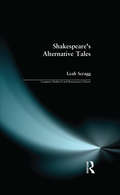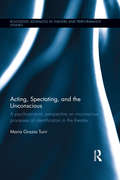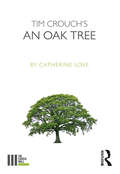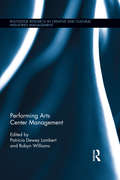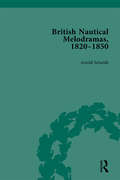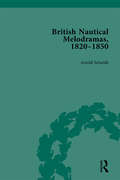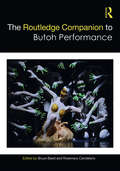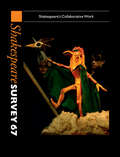- Table View
- List View
The Witlings and the Woman Hater (Pickering Women's Classics)
by Geoffrey M SillThis edition contains two of Frances Burney's comedies: "The Witlings", (1778-80) which satirizes the bluestockings; and "The Woman Hater" (1800-02), which explores social pretension and gender conflict.
Joanna Baillie: A Selection of Poems and Plays (Pickering Women's Classics)
by Amanda GilroyThis work includes Joanna Baillie's important poems and critical prefaces, the tragedies "De Montfort" and "Basil", and the comedy, "The Alienated Manor", together with substantial extracts from her other works.
The Complete Plays of Frances Burney: Full-text Database: Macintosh Format (The Pickering Masters)
by Tristanne J CookeThe complete plays of Fanny Burney, taken from the original manuscripts of her work. The work includes a general introduction, headnotes to each play, explanatory notes and variant readings.
English Drama of the Early Modern Period 1890-1940 (Longman Literature In English Series)
by Jean ChothiaThe period 1890-1940 was a particularly rich and influential phase in the development of modern English theatre: the age of Wilde and Shaw and a generation of influential actors and managers from Irving and Terry to Guilgud and Olivier.Jean Chothia's study is in two parts beginning with a portrait of the period, setting the narrative context and considering the dramatic social and cultural changes at work during this time. It then focuses on some of the main themes in the theatre, from Shaw and comedy, to the rise of political and radio drama, providing an interpretative framework for the period. This volume will be of great benefit to students and academics of English literature and drama, as it covers the work of the major dramatists of the period as well as considering the dramatic output of literary figures, such as James, Eliot and Lawrence.
New Historicism and Renaissance Drama (Longman Critical Readers)
by Richard Wilson Richard DuttonNew Historicism has been one of the major developments in literary theory over the last decade, both in the USA and Europe. In this book, Wilson and Dutton examine the theories behind New Historicism and its celebrated impact in practice on Renaissance Drama, providing an important collection both for students of the genre and of literary theory.
Taming of the Shrew: First Quarto of "Taming of a Shrew" (Shakespearean Originals--first Editions Ser.)
by Graham Holderness Bryan LoughreyFirst Published in 1992. This series puts into circulation single annotated editions of early modern play-texts whose literary and theatrical histories have been overshadowed by editorial practices dominant since the eighteenth century. The text contained in this volume is not what we know as Shakespeare's The Taming of the Shrew, modern editions of which play are all derived from the text printed in the 1623 First Folio edition of Shakespeare's works. The present text is an edition of the play published in 1594 under the title The Taming of a Shrew, which has always been denied the authorising signature of 'Shakespeare', and regarded as an earlier version by another dramatist or as a pirated and corrupt 'memorial reconstruction' of Shakespeare's The Taming of the Shrew.
Shakespeare's Alternative Tales (Longman Medieval and Renaissance Library)
by Leah ScraggA knowledge of the history and evolution of the tales on which Shakespeare drew in the composition of his plays is essential for the understanding of his work. In re-telling a particular story, a Renaissance writer was not simply reshaping the structure of the narrative but participating in a species of debate with earlier writers and the meanings their tales had accrued. The stories upon which Shakespeare's plays are constructed did not descend to him as innocent collections of incidents, but brought with them considerable cultural baggage, substantially lost to the modern spectator but an essential component, for a contemporary audience, of the meaning of the work.Shakespeare's Alternative Tales explores this literary dialogue, focusing on those plays in which the expectations generated by an inherited story are in some way overthrown, setting up a tension for a Renaissance spectator between 'received' and 'alternative' readings of the text. Each chapter opens with a familiar story, supplying a context for the subsequent discussion, and exhibits the way in which the dramatist's reworking of a traditional motif interrogates the assumptions implicit in his source.While offering the twentieth-century reader a fresh perspective from which to view the plays, the approach also supplies an introduction to contemporary readings of the Shakespearean canon. The tales Leah Scragg considers may be seen as 'alternative' in more than one sense: they radically rework conventional situations, while lending themselves to analysis in terms of new critical methodologies.The text will be of interest to both students of Shakespeare and the general reader. In conjunction with the author's companion volume, Shakespeare's Mouldy Tales, it provides an ideal introduction to contemporary developments in source studies.
Acting, Spectating and the Unconscious: A psychoanalytic perspective on unconscious mechanisms of identification in spectating and acting in the theatre. (Routledge Advances in Theatre & Performance Studies)
by Maria Grazia TurriFrom Aristotle’s theory of tragic katharsis onwards, theorists of the theatre have long engaged with the question of what spectatorship entails. This question has, directly or indirectly, often been extended to the investigation of acting. Acting, Spectating, and the Unconscious approaches the unconscious aspects of spectatorship and acting afresh. Interweaving psychoanalytic descriptions of processes such as transference, unconscious phantasy, and alpha-function with an in-depth survey of theories of spectating and acting from thinkers such as Brecht, Diderot, Rousseau and Plato, Maria Grazia Turri offers a significant insight into the emotions inherent in both the art of the actor, and the spectator’s experience. A compelling investigation of the unconscious communication between spectators and actors, this volume is a must-read for students and scholars fascinated by theatre spectatorship.
An Oak Tree
by Catherine LoveFirst Published in 2017. Routledge is an imprint of Taylor & Francis, an Informa company.
Performing Arts Center Management (Routledge Research in the Creative and Cultural Industries)
by Patricia Dewey Lambert Robyn WilliamsPerforming arts centers (PACs) are an integral part of the cultural and creative industries, significantly influencing the cultural, social, and economic vitality of communities around the world. Virtually all PACs are community-based and serve the public interest, whether structured as a public, nonprofit, for-profit, or hybrid entity. However, there is a lack of knowledge about the important community role of performing arts centers, especially those that mainly host and present work produced by other arts organizations. This gap is startling, given the ubiquitous presence of PACs in urban centers, small communities, as well as colleges and universities. This co-edited reference book provides valuable information at the intersection of theory and practice in the professional field of executive leadership of performing arts centers. Drawing on the expertise of leading academics, consultants, and executives, this book focuses on institutions and practices in the United States, and is contextualized within additional fields such as cultural planning, urban revitalization, and economic development. Performing Arts Center Management aims to provide valuable theoretical, conceptual, empirical, and practice-based information to current and future leaders in creative and cultural industries management. It serves as a unique reference for researchers, university students, civic leaders, urban planners, public venue managers, and arts administrators aspiring to improve or advance their work in successfully managing performing arts centers.
British Nautical Melodramas, 1820–1850: Volume III
by Arnold SchmidtDuring the 1820s and 30s nautical melodramas "reigned supreme" on London stages, entertaining the mariners and maritime workers who comprised a large part of the audience for small theatres with the same sentimental moments and comic interludes of domestic melodrama mixed with patriotic images that communicated and reinforced imperial themes. However, generally the study of British theatre history moves from medieval and renaissance plays directly to the realism and naturalism of late Victorian and modern drama. Readers typically encounter a gap between Restoration and eighteenth-century plays like those of Oliver Goldsmith and Richard Brinsley Sheridan, and late-nineteenth plays by Henrik Ibsen and Oscar Wilde. Nineteenth-century drama, with the possible exception of plays by Byron, Shelley, and Wordsworth, remains all but invisible. Until recently, melodramatic plays written and performed during this "gap" received little scholarly attention, but their value as reflections of Britain’s promulgation of imperial ideology — and its role in constructing and maintaining class, gender, and racial identities — have given discussions of melodrama force and momentum. The plays in included in these three volumes have never appeared in a critical anthology and most have not been republished since their original nineteenth-century editions. Each play is transcribed from the original documents and includes an author biography, a headnote about the play itself, full annotations with brief definitions of unfamiliar vocabulary, and explanatory notes. Comprehensive editorial apparatus details the nineteenth-century imperial, naval, political, and social history relevant to the plays’ nautical themes, as well as discussing nineteenth-century theatre history, melodrama generally, and the nautical melodrama in particular. Contemporary theatre practices — acting, audiences, staging, lighting, special effects — are also examined. An extensive bibliography of primary and secondary texts; a complete index; and contemporary images of the actors, theatres, stage sets, playbills, costumes, and locales have been compiled to aid study further. The appendices include maps of Britain, Europe, and the East and West Indies.
British Nautical Melodramas, 1820–1850: Volume II
by Arnold SchmidtDuring the 1820s and 30s nautical melodramas "reigned supreme" on London stages, entertaining the mariners and maritime workers who comprised a large part of the audience for small theatres with the same sentimental moments and comic interludes of domestic melodrama mixed with patriotic images that communicated and reinforced imperial themes. However, generally the study of British theatre history moves from medieval and renaissance plays directly to the realism and naturalism of late Victorian and modern drama. Readers typically encounter a gap between Restoration and eighteenth-century plays like those of Oliver Goldsmith and Richard Brinsley Sheridan, and late-nineteenth plays by Henrik Ibsen and Oscar Wilde. Nineteenth-century drama, with the possible exception of plays by Byron, Shelley, and Wordsworth, remains all but invisible. Until recently, melodramatic plays written and performed during this "gap" received little scholarly attention, but their value as reflections of Britain’s promulgation of imperial ideology — and its role in constructing and maintaining class, gender, and racial identities — have given discussions of melodrama force and momentum. The plays in included in these three volumes have never appeared in a critical anthology and most have not been republished since their original nineteenth-century editions. Each play is transcribed from the original documents and includes an author biography, a headnote about the play itself, full annotations with brief definitions of unfamiliar vocabulary, and explanatory notes. Comprehensive editorial apparatus details the nineteenth-century imperial, naval, political, and social history relevant to the plays’ nautical themes, as well as discussing nineteenth-century theatre history, melodrama generally, and the nautical melodrama in particular. Contemporary theatre practices — acting, audiences, staging, lighting, special effects — are also examined. An extensive bibliography of primary and secondary texts; a complete index; and contemporary images of the actors, theatres, stage sets, playbills, costumes, and locales have been compiled to aid study further. The appendices include maps of Britain, Europe, and the East and West Indies.
British Nautical Melodramas, 1820–1850: Volume I
by Arnold SchmidtDuring the 1820s and 30s nautical melodramas "reigned supreme" on London stages, entertaining the mariners and maritime workers who comprised a large part of the audience for small theatres with the same sentimental moments and comic interludes of domestic melodrama mixed with patriotic images that communicated and reinforced imperial themes. However, generally the study of British theatre history moves from medieval and renaissance plays directly to the realism and naturalism of late Victorian and modern drama. Readers typically encounter a gap between Restoration and eighteenth-century plays like those of Oliver Goldsmith and Richard Brinsley Sheridan, and late-nineteenth plays by Henrik Ibsen and Oscar Wilde. Nineteenth-century drama, with the possible exception of plays by Byron, Shelley, and Wordsworth, remains all but invisible. Until recently, melodramatic plays written and performed during this "gap" received little scholarly attention, but their value as reflections of Britain’s promulgation of imperial ideology — and its role in constructing and maintaining class, gender, and racial identities — have given discussions of melodrama force and momentum. The plays in included in these three volumes have never appeared in a critical anthology and most have not been republished since their original nineteenth-century editions. Each play is transcribed from the original documents and includes an author biography, a headnote about the play itself, full annotations with brief definitions of unfamiliar vocabulary, and explanatory notes. Comprehensive editorial apparatus details the nineteenth-century imperial, naval, political, and social history relevant to the plays’ nautical themes, as well as discussing nineteenth-century theatre history, melodrama generally, and the nautical melodrama in particular. Contemporary theatre practices — acting, audiences, staging, lighting, special effects — are also examined. An extensive bibliography of primary and secondary texts; a complete index; and contemporary images of the actors, theatres, stage sets, playbills, costumes, and locales have been compiled to aid study further. The appendices include maps of Britain, Europe, and the East and West Indies.
The Routledge Companion to Butoh Performance (Routledge Companions)
by Rosemary Candelario Bruce BairdThe Routledge Companion to Butoh Performance provides a comprehensive introduction to and analysis of the global art form butoh. Originating in Japan in the 1960s, butoh was a major innovation in twentieth century dance and performance, and it continues to shape-shift around the world. Taking inspiration from the Japanese avant-garde, Surrealism, Happenings, and authors such as Genet and Artaud, its influence can be seen throughout contemporary performing arts, music, and visual art practices. This Companion places the form in historical context, documents its development in Japan and its spread around the world, and brings together the theory and the practice of this compelling dance. The interdisciplinarity evident in the volume reflects the depth and the breadth of butoh, and the editors bring specially commissioned essays by leading scholars and dancers together with translations of important early texts.
Costume in the Comedies of Aristophanes
by Gwendolyn Compton-EngleThis book offers an interpretation of the handling of costume in the plays of the fifth-century comic poet Aristophanes. Drawing on both textual and material evidence from the fourth- and fifth-century Greek world, it examines three layers of costume: the bodysuit worn by the actors, the characters' clothes, and the additional layering of disguise. A chapter is also devoted to the inventive costumes of the comic chorus. Going beyond describing what costumes looked like, the book focuses instead on the dynamics of costume as it is manipulated by characters in the performance of plays. The book argues that costume is used competitively, as characters handle each other's costumes and poets vie for status using costume. This argument is informed by performance studies and by analyses of gender and the body.
The World of Tacitus' Dialogus de Oratoribus
by Christopher S. van den BergComing to terms with the rhetorical arts of antiquity necessarily illuminates our own ideas of public discourse and the habits of speech to which they have led. Tacitus wrote the Dialogus at a time (ca. 100 CE) when intense scrutiny of the history, the definitions, and the immediate relevance of public speech were all being challenged and refashioned by a host of vibrant intellects and ambitious practitioners. This book challenges the notion that Tacitus sought to explain the decline of oratory under the Principate. Rather, from examination of the dynamics of argument in the dialogue and the underlying literary traditions there emerges a sophisticated consideration of eloquentia in the Roman Empire. Tacitus emulates Cicero's legacy and challenges his position at the top of Rome's oratorical canon. He further shows that eloquentia is a means by which to compete with the power of the Principate.
The Shakespearean Archive
by Alan GaleyWhy is Shakespeare so often associated with information technologies and with the idea of archiving itself? Alan Galey explores this question through the entwined histories of Shakespearean texts and archival technologies over the past four centuries. In chapters dealing with the archive, the book, photography, sound, information, and data, Galey analyzes how Shakespeare became prototypical material for publishing experiments, and new media projects, as well as for theories of archiving and computing. Analyzing examples of the Shakespearean archive from the seventeenth century to today, he takes an original approach to Shakespeare and new media that will be of interest to scholars of the digital humanities, Shakespeare studies, archives, and media history. Rejecting the idea that current forms of computing are the result of technical forces beyond the scope of humanist inquiry, this book instead offers a critical prehistory of digitization read through the afterlives of Shakespeare's texts.
Popular Musical Theatre in London and Berlin
by Len Platt Tobias Becker David Linton Len Platt Tobias BeckerIn the decades before the Second World War, popular musical theatre was one of the most influential forms of entertainment. This is the first book to reconstruct early popular musical theatre as a transnational and highly cosmopolitan industry that included everything from revues and operettas to dance halls and cabaret. Bringing together contributors from Britain and Germany, this collection moves beyond national theatre histories to study Anglo-German relations at a period of intense hostility and rivalry. Chapters frame the entertainment zones of London and Berlin against the wider trading routes of cultural transfer, where empire and transatlantic song and dance produced, perhaps for the first time, a genuinely international culture. Exploring adaptations and translations of works under the influence of political propaganda, this collection will be of interest both to musical theatre enthusiasts and to those interested in the wider history of modernism.
Shakespeare Survey: Volume 67, Shakespeare's Collaborative Work
by Peter Holland Ton HoenselaarsShakespeare Survey is a yearbook of Shakespeare studies and production. Since 1948 Survey has published the best international scholarship in English and many of its essays have become classics of Shakespeare criticism. Each volume is devoted to a theme, or play, or group of plays; each also contains a section of reviews of the previous year's textual and critical studies and of major British performances. The books are illustrated with a variety of Shakespearean images and production photographs. The current editor of Survey is Peter Holland. The first eighteen volumes were edited by Allardyce Nicoll, numbers 19-33 by Kenneth Muir and numbers 34-52 by Stanley Wells. The virtues of accessible scholarship and a keen interest in performance, from Shakespeare's time to our own, have characterized the journal from the start. For the first time, numbers 1-50 are being reissued in paperback, available separately and as a set.<P> The theme for Volume 67 is 'Shakespeare's Collaborative Work'. The complete set of Survey volumes is also available online at http://www.cambridge.org/online/shakespearesurvey. This fully searchable resource enables users to browse by author, essay and volume, search by play, theme and topic, and save and bookmark their results.
Home on the Stage
by Nicholas GreneAs a serious drama set in an ordinary middle-class home, Ibsen's A Doll's House established a new politics of the interior that was to have a lasting impact upon twentieth-century drama. In this innovative study, Nicholas Grene traces the changing forms of the home on the stage through nine of the greatest of modern plays and playwrights. From Chekhov's The Cherry Orchard through to Williams's A Streetcar Named Desire, domestic spaces and personal crises have been employed to express wider social conditions and themes of class, gender and family. In the later twentieth century and beyond, the most radically experimental dramatists created their own challenging theatrical interiors, including Beckett in Endgame, Pinter in The Homecoming and Parks in Topdog/Underdog. Grene analyses the full significance of these versions of domestic spaces to offer fresh insights into the portrayal of the naturalistic environment in modern drama.
Romantic Tragedies
by Reeve ParkerTroubled politically and personally, Wordsworth and Coleridge turned in 1797 to the London stage. Their tragedies, The Borderers and Osorio, were set in medieval Britain and early modern Spain to avoid the Lord Chamberlain's censorship. Drury Lane rejected both, but fifteen years later, Coleridge's revision, Remorse, had spectacular success there, inspiring Shelley's 1819 Roman tragedy, The Cenci, aimed for Covent Garden. Reeve Parker makes a striking case for the power of these intertwined works, written against British hostility to French republican liberties and Regency repression of home-grown agitation. Covertly, Remorse and The Cenci also turn against Wordsworth. Stressing the significance of subtly repeated imagery and resonances with Virgil, Shakespeare, Racine, Jean-François Ducis and Schiller, Parker's close readings, which are boldly imaginative and decidedly untoward, argue that at the heart of these tragedies lie powerful dramatic uncertainties driven by unstable passions - what he calls, adapting Coleridge's phrase for sorcery, 'dark employments'.
Terence
by Sander M. GoldbergTerence's Hecyra raises social, literary and theatrical issues of great interest to modern students of Roman comedy and, indeed, of Roman culture more broadly. The play pays strikingly close attention to the domestic problems of women and experiments boldly with traditional comic forms, not only in its creation of anticipatory suspense, but through its variations on traditional situations and roles and its metatheatrical qualities. In addition, Terence's response in his prologues to the play's two putative failures is important, if tendentious, evidence for the mechanics of theatrical performance in the second century, especially the conjunction of theatrical and gladiatorial shows. This edition opens the play's many interpretive challenges to wider scrutiny while remaining attentive to the linguistic needs of students at all levels.
The First Frame
by Pannill CampIn the late eighteenth century, a movement to transform France's theatre architecture united the nation. Playwrights, philosophers, and powerful agents including King Louis XV rejected the modified structures that had housed the plays of Racine and Molière, and debated which playhouse form should support the future of French stagecraft. In The First Frame, Pannill Camp argues that these reforms helped to lay down the theoretical and practical foundations of modern theatre space. Examining dramatic theory, architecture, and philosophy, Camp explores how architects, dramatists, and spectators began to see theatre and scientific experimentation as parallel enterprises. During this period of modernisation, physicists began to cite dramatic theory and adopt theatrical staging techniques, while playwrights sought to reveal observable truths of human nature. Camp goes on to show that these reforms had consequences for the way we understand both modern theatrical aesthetics and the production of scientific knowledge in the present day.
Shakespeare Survey: Volume 62, Close Encounters with Shakespeare's Text
by Peter HollandShakespeare Survey is a yearbook of Shakespeare studies and production. Since 1948 Survey has published the best international scholarship in English and many of its essays have become classics of Shakespeare criticism. Each volume is devoted to a theme, or play, or group of plays; each also contains a section of reviews of the previous year's textual and critical studies and of major British performances. The books are illustrated with a variety of Shakespearean images and production photographs. The current editor of Survey is Peter Holland. The first eighteen volumes were edited by Allardyce Nicoll, numbers 19-33 by Kenneth Muir and numbers 34-52 by Stanley Wells. The virtues of accessible scholarship and a keen interest in performance, from Shakespeare's time to our own, have characterized the journal from the start. For the first time, numbers 1-50 are being reissued in paperback, available separately and as a set.<P> The theme for volume 62 is 'Close Encounters with Shakespeare's Text'. The complete set of Survey volumes is also available online at http://www.cambridge.org/online/shakespearesurvey. This fully-searchable resource enables users to browse by author, essay and volume, search by play, theme and topic, and save and bookmark their results.
Shakespeare Survey: Volume 64, Shakespeare as Cultural Catalyst
by Peter HollandShakespeare Survey is a yearbook of Shakespeare studies and production. Since 1948 Survey has published the best international scholarship in English and many of its essays have become classics of Shakespeare criticism. Each volume is devoted to a theme, or play, or group of plays; each also contains a section of reviews of the previous year's textual and critical studies and of major British performances. The books are illustrated with a variety of Shakespearean images and production photographs. The current editor of Survey is Peter Holland. The first eighteen volumes were edited by Allardyce Nicoll, numbers 19-33 by Kenneth Muir and numbers 34-52 by Stanley Wells. The virtues of accessible scholarship and a keen interest in performance, from Shakespeare's time to our own, have characterized the journal from the start. For the first time, numbers 1-50 are being reissued in paperback, available separately and as a set.<P> The theme for volume 64 is 'Shakespeare as Cultural Catalyst'. The complete set of Survey volumes is also available online at http://www.cambridge.org/online/shakespearesurvey. This fully-searchable resource enables users to browse by author, essay and volume, search by play, theme and topic, and save and bookmark their results.
